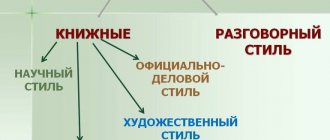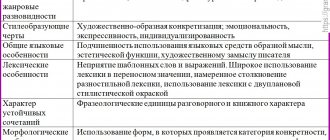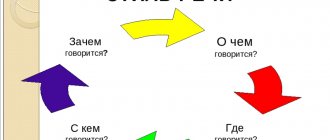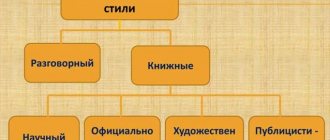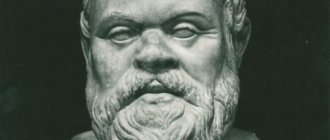History of the style
Scientific language arose due to the fact that various narrow-profile areas of life were rapidly developing. At first it could be compared with an artistic style of speech, but over time it began to differ, acquiring its own characteristic features and characteristics.
In ancient times in Greece, a privileged class of people used a special terminology that ordinary citizens could not perceive correctly. At the same time, experts began to identify the main features of the scientific style of speech. Initially, the terms were used exclusively in Latin, but then all the world's scientists made translations into their native languages.
Over time, the style of the scientific text became precise and concise, which separated it as much as possible from the literary presentation. After all, artistic language introduces significant coloration into the perception of the text, which is unacceptable for the scientific style.
The scientific style of speech and its definition developed rather slowly. The opinions of representatives of science regarding the use of styles were significantly divided. This can be judged by Descartes’ negative statements regarding the works of Galileo. He said that his scientific works contain many artistic means. Kepler was also of this opinion, who believed that Galileo quite often used a literary description of the nature of things.
One of the important stages in the development of the scientific style of speech was the works of Isaac Newton. For a long time they served as a kind of standard of style that everyone tried to adhere to when presenting information.
The scientific style in the Russian state began to take shape only at the beginning of the 18th century. At this historical stage, people writing their own texts or translating began to form their own terminology.
In the second half of the 18th century, the famous scientist Mikhail Lomonosov, together with his followers, gave impetus to the formation of a characteristic scientific type of speech in Russia. Most experts took his works as a basis. The basic scientific terms were finally created only at the end of the 19th century.
Varieties of scientific language
According to modern standards, there are several types of scientific style in the Russian language, which have their own characteristics. These include the following speech styles:
Popular science
This type of text is addressed to those people who do not have special skills and knowledge in any specific area. It is characterized by simplicity of presentation in order to achieve accessibility for the public, but at the same time it retains a sufficient amount of terminology and clarity.
In addition, it is allowed to use such speech forms that evoke emotion in the audience. The purpose of scientific public language is to familiarize people with certain facts or phenomena.
This species also has a subspecies called scientific and artistic. With this presentation, a minimum of special terminology and numerical values are used, and if they exist, then experts try to explain them in detail.
The popular science style is characterized by comparative analysis with ordinary objects, easy reading and perception of information. This text is used in books, magazines and other publications.
Training
It is designed for people studying in educational institutions. The purpose of this style is to introduce pupils and students to the information that is required to acquire certain knowledge in a particular area.
The scientific style and its features in this case consist in the use of many typical examples. This style is characterized by the use of professional terms, a clear division into categories, and smooth transitions from the general to the specific. Such texts can be found in textbooks, manuals, and manuals.
Actually scientific
In this case, the audience is people specializing in the field and scientists. The task of such texts is to describe certain facts, phenomena, patterns, and so on. You can draw your own conclusions in them, but do not color them with special emotionality. An example of this type of scientific style can be found in dissertations, reports, and reviews.
Technical
This type is necessary for highly specialized specialists. The purpose of this style is to describe skills and abilities that were acquired through practical means. It is characterized by a lot of digital, statistical data and technical characteristics.
Oral speech
The scientific style of speech is used not only for writing papers. It is widely used in oral speech. It is used when speaking at conferences, symposiums, and seminars. In this case, the style retains its main features - accuracy, logic, objectivity and abstraction.
In oral speech, several genres are distinguished. When monologuing, a person does not take into account the reaction of another person. Varieties of monologue - report, message, defense of coursework or final qualifying work.
Oral speech can also be presented in the form of dialogue. For example, the scientific community may have a discussion. In this case, a discussion of some controversial topic occurs. It should not be confused with scientific conversation. This type is characterized by a calm discussion of the message being listened to. People can exchange opinions and add information.
There are two more types of oral speech - lectures. Training lectures are held to ensure that students have knowledge in the professional field. There are also popular lectures that are focused on obtaining information. They are carried out sporadically and presented in a simplified form.
There are different speech styles in the Russian language. Each of them performs its own tasks and is used in certain conditions. Scientific is found in dissertations, reports, specialized books and other works. When using this style, it is important to adhere to the above rules.
Signs of style
Over time, the scientific style of speech, definition and its features have undergone changes. In modern times, some patterns of such presentation of information have already emerged.
Scientists identify the main features of a scientific style of speech, in connection with which the text should be:
- Logical. This trait is the most basic for using this speech style. Absolutely any coherent statement must have the specified property. But at the same time, scientific language is distinguished by its own logic, which is characterized by emphasis and rigor. All components of information have a strict semantic connection and are presented in a strictly sequential chain, ending with conclusions. This is achieved by using means characteristic of scientific texts, for example, sentences are connected by repeating nouns, which are often combined with demonstrative pronouns. Also, the fact that the information is presented sequentially is indicated by frequently occurring adverbs, introductory words, and conjunctions.
- Accurate. This is another important property that indicates that the text is written in a scientific style. In order to accurately present all the information, words are selected very carefully. However, they are used exclusively in the literal sense. In addition, terminology and special vocabulary are widely used. In such texts you can often find multiple repetitions of key phrases, which is absolutely normal.
- Objective. This trait also applies to scientific style. Such texts present only objective information, for example, they describe the results of experiments and patterns identified during their implementation. All described information requires reliable quantitative and qualitative characteristics.
- Generalized. This important feature necessarily contains any examples of texts in a scientific style. In this regard, specialists often resort to the use of abstract concepts that are almost impossible to imagine, feel, or see.
When presenting scientific information, words that have an abstract meaning are used. Often they use formulas, symbols, provide graphs, make tables, draw diagrams and drawings. All this allows us to most clearly reveal and explain this or that phenomenon.
The scientific style of speech is not characterized by the use of exclamatory statements, as well as one’s own subjective opinion. Therefore, in such texts personal pronouns and verbs in the first person singular are rarely used. Usually they use vaguely personal, impersonal, and definitely personal expressions.
All of the above signs make it possible to understand that the scientific style of speech is not characterized by emotionality or excessive coloration of phenomena.
The text must be logical, accurate, and true. All this is achieved due to the fact that when presenting information, certain rules of a scientific text are adhered to.
Manner of presentation of scientific text
Depending on the topic of the material, the terminology and manner of presentation naturally differ. Texts on physics and philosophy cannot be too similar.
But there is always a set of common features that are always present in a scientific text, be it an article, a textbook or a monograph.
As for oral text, for example, a report at a conference, this is:
- Scientific text is always impersonal. It is never written in the first person.
- This is a dry, unemotional, maximally formalized presentation, devoid of figurative language.
- Contains an abundance of terms.
- The use of colloquial language is not permitted.
For written text, all of the above is also true. But beyond this, written texts are characterized by the use of tables, graphs and diagrams.
Characteristics of scientific information
The scientific style and its features have been formed for a long time and have undergone many changes. Currently, there are three groups of characteristic features of this language:
- lexical;
- morphological;
- syntactic.
Each of these groups reveals specific features that distinguish scientific stylistics of speech from all others. Therefore, it is worth considering them in more detail.
Vocabulary
The scientific style and its vocabulary features are based on the fact that such information has its own immediate task, which is to identify phenomena, objects, name them, and explain them. To achieve this goal, nouns are required first.
The vocabulary of the scientific style has the following characteristic features:
- Words are used exclusively in the literal sense.
- When presenting information, the means by which various images are described in literary works are not used. These include epithets, metaphor, comparison, hyperbole.
- Abstract sentences and terminology are often used.
Features of the scientific style of speech are the identification of three groups of words:
- Stylistically neutral. They are used in any speech styles, which is why they are called generally accepted.
- General scientific. They may contain an example of the scientific style of different areas, rather than just one area.
- Highly specialized. These are words that are characteristic of a specific scientific field.
Morphology
Features of the scientific style of speech include morphology. When disclosing information, the following shall be taken into account:
- In texts it is extremely rare to find the use of verbs in the first or second person singular. In a literary style, this is quite acceptable.
- They use many verbs in the present tense, which are quite similar to verbal nouns. Their use makes it possible to convey a reliable assessment of facts and phenomena quite well.
- The scientific style is not characterized by a feature of presentation in which a large accumulation of adjectives can be found in works. They are rarely used, and they are mostly included in specialized terms. While in a literary text they are used a lot along with epithets and other artistic means.
- When revealing scientific information, parts of speech and their grammatical forms are used slightly differently than in texts of other speech styles.
Formation of scientific style in the Russian literary language of the second half of the 18th century
Article on the topic: “Formation of scientific style in the Russian literary language of the second half of the 18th century”
Author of the work: Shanicheva Anastasia Alekseevna, teacher of Russian language and literature
Scientific style in the literary language of the 18th century.
- Review of literature devoted to the study of the scientific style of speech in the 18th century.
“Scientific style represents the scientific sphere of communication and speech activity associated with the implementation of science as a form of social consciousness. It reflects theoretical thinking, appearing in a conceptual-logical form, which is characterized by objectivity and abstraction from the concrete and random, logical evidence and consistency of presentation” [24, p. 243].
R.A. Budagov notes that the style of scientific presentation is a strictly historical category. In different countries it was created at different times. The prerequisites for its design and further development were determined:
1. The general state of science and scientific knowledge in a given country.
2. The degree of development of the literary-processed language.
3. Great masters, writers and scientists who turned to their native language in their scientific, historical and critical writings.
As for the general properties of the scientific style, their characteristics are R.A. Budagov summarizes:
1. To the widespread use of various symbols, which partially replace words.
2. To the inaccessibility of the presentation.
3. To the coldness of presentation.
4. To relatively easy conduction from one language to another [3].
The purpose of a scientific text is to present, classify and summarize facts, put forward an idea, provide logical evidence, formulate patterns and laws. The main task is to convey clear and accurate information to the reader, which is achieved through the use of special scientific terms. It is believed that this can best be achieved without the use of any emotional expressive means, since science is addressed primarily to the mind, and not to feelings [10].
Various authors have addressed the study of scientific style. They also studied various aspects of this topic in relation to the 18th century. So, for example, in the work of M.P. Kotyurova “Evolution of the expression of speech coherence in the scientific style of the 18th – 20th centuries.” the functional-semantic category of speech coherence, its concept, characteristics, features of the expression of logical-semantic relations are considered [14].
M.N. Kozhina, V.A. Salimovsky and M.P. Kotyurov in the monograph “The Development of Scientific Style in the Aspect of the Functioning of Linguistic Units at Different Levels” presents general problems in the history of the formation of the scientific style in the 18th-20th centuries. They considered the issues of its periodization, analyzed its lexical and morphological composition using statistical data and a large number of examples [12].
T.B. Trosheva and S.O. Glushakova continue to study this issue in the work “Development of scientific style in the aspect of the functioning of linguistic units of various levels, part 2: Syntax.” Here we examine the evolution of the study of syntactic relations in scientific texts. Statistical data and examples are also provided [20].
P.D. Filkova in her book “History of the Russian Literary Language” analyzed the role of M.V. Lomonosov in the development of scientific style and Russian scientific terminology [21].
Labor L.L. Kutina “Formation of the language of Russian science: (Terminology of mathematics, astronomy, geography in the first third of the 18th century)” touches on the issue of the formation of the terminology of Russian science (the terminology of mathematics, astronomy and geography is considered). Historical information about the scientific style of the 18th century is given. [16]. And in the work “Formation of physics terminology in Russia: The pre-Lomonosov period: the first third of the 18th century.” she continues her previous work. He studies the problem of formation using the material of Russian books on physics and mechanics [15].
In the article by L.S. Girenko “Lexical means of expressing density of content (in Russian scientific texts of the 18th century)” examines different classes of words in Russian scientific texts of the 18th century. taking into account the influence of the selection and use of these words on the “explicit expression of text density” [6, p. 141].
M.N. Kozhina and N.M. Kapustin in his article “The Evolution of the Use of Two Semantic Groups of Verbs in Russian Scientific Texts” explores the uniqueness in the functioning of verbs of specific physical action and verbs of movement in scientific texts, and also whether there has been an evolution in the use of these groups over the period from the mid-18th century. until the 20th century [13].
In the article by A.A. Tsarev “Complex words in the language of scientific prose M.V. Lomonosov" describes the study of complex words in scientific texts by M.V. Lomonosov. It contains only the main points of the origin and composition of this vocabulary [22].
The significance of the works of M.V. Lomonosov for the history of the Russian language is touched upon by N.A. Meshchersky in his work “History of the Russian Literary Language”, as well as his merits in the development of scientific terminology, in the translation of foreign terms into Russian, that his work was continued by other scientists (“the scientific style of the Russian literary language, the foundation of which was laid in the works of Lomonosov, continued to improve and develop") [17, p. 109].
A.I. Efimov also spoke about the role of M.V. Lomonosov for science, about his works and analyzes of his activities, that “it is to him that we owe such an early appearance in Russia of stylistic observations and research... he was the founder of the stylistics of the native language...” [9, p. 37].
V.P. Vompersky examined in detail the origin of “gender genders” in the Russian language in his work “The Stylistic Doctrine of M.V. Lomonosov and the theory of three styles". He also examined the semantic history of the words “style” and “calm” in the 18th century. He paid special attention to the consideration of Lomonosov’s theory of “calms” [5].
In “History of the Russian Literary Language” L.V. Sudavičienė gives a general description of the 18th century, the processes occurring at that time in the Russian language, paying special attention to words borrowed from different languages, and speaks about the development of science and scientific language during this period [19].
Thus, the following aspects of the formation of scientific style in the 18th century have been studied: the category of speech coherence, lexical, morphological and syntactic level, as well as the contribution of M.V. Lomonosov to this area.
- Characteristics of the scientific style in the 18th century.
The 18th century is an important stage in the formation of the modern Russian literary language, which is full of contradictions and difficulties in its development. This is an era of decisive changes in Russia. In 1725, the Academy of Sciences began to operate with a gymnasium and a university. In 1755, Moscow University and gymnasium opened. The first women's educational institutions and private boarding schools appeared. In 1783, the first philological scientific institution was opened - the Russian Academy, which set as its task the creation of a dictionary, grammar and rhetoric of the Russian language. From the very beginning of the century there has been a transition from traditional handwritten reproduction of dictionaries to printing [11].
Central figure in science and culture of the 18th century. is M.V. Lomonosov (1711-1765). His scientific prose, of course, deserves special attention, since M.V. Lomonosov was called the creator of the scientific Russian language. He identified functional varieties of a single literary language (“kinds of verbs”) on an all-Russian folk basis, which he called “calms.” But the doctrine of three styles is known to both ancient and medieval rhetoricians. Therefore, the merit of M.V. Lomonosov is not that he substantiated the theory of three styles, but that it was he who determined the norms of these styles, developed the doctrine of the principles and methods of their construction, and indicated the ways of combining Russian and Church Slavonic vocabulary in the Russian literary language.
According to P.D. Filkova, “Lomonosov’s scientific works and his translations of scientific books give an idea of how the scientific style was formed and developed, how it was influenced by the style of fiction, to what extent there was still a lack of precise terms, due to which it was necessary to resort to figurative comparisons, analogies and explanations" [21, p. 195].
L.L. Kutina writes that from a historical perspective, M.V. Lomonosov is the first person to contact with the question of Russian scientific style. The history of the Russian scientific language of modern times usually begins from him, but at the same time the first third of the 18th century is forgotten, which played a significant role in its formation [16].
Lomonosov began his scientific activities at the very end of the 30s - early 40s. XVIII century This time was preceded by more than 15 years of activity of the Russian Society of Sciences - the Russian Academy. She published a number of her works. The range of scientific ideas and concepts that the scientific writing of the Dolomonosov era used was already very wide. One of the features of scientific literature of this time was its pronounced educational character. The educated society of the Peter the Great era promoted scientific knowledge, and Peter I himself noted its importance, and was also the editor of scientific translations. The beginning of the 18th century, as noted by P.D. Filkova, is the time of the emergence of the first gymnasiums and schools, the compilation and translation of textbooks and popular science books (for example, “Arithmetic” by L. Magnitsky), the publication of more than 600 books, among which were grammars and dictionaries [21].
The next feature was that scientific books were the object of conscious and purposeful actions in the field of language. The first scientific books were in most cases translated. However, gradually the Russian literary language will increasingly adapt to express complex scientific thought, develop not only at the lexical (its terminology) level, but also at the syntactic level, which will gradually free itself from cumbersome constructions and be formed to clearly express the content of scientific knowledge [12].
The language of scientific books of the 30s. both in terminology and syntax it was the most processed and perfect among other genres and types of literary expression of that time. This is what determines the emergence of such masters of scientific language as M.V. Lomonosov, S.P. Krasheninnikov, P.I. Rychkov, and later I.I. Lepekhin, S.Ya. Rumovsky, N.Ya. Ozeretskovsky and others.
In the dictionary of scientific books, the most significant lexical level that carries the function of conveying scientific concepts is terminological vocabulary, which is also an outstanding merit of M.V. Lomonosov. Thanks to his numerous scientific works and the introduction of a large number of new terms into them, “the foundations of the scientific language are laid, and national Russian terminology is created” [2].
Yu.S. Sorokin draws attention to the fact that it is from the 17th century. XVIII century inherited a certain amount of knowledge in some scientific fields. But even here the concepts were not always uniformly defined terminologically. In other cases, Russian scientific terminology in the 18th century. had to be created anew or significantly changed and supplemented [23]. However, the activities of M.V. Lomonosov and other outstanding figures of Russian science in the 18th century. not only enriched science with various discoveries, but also created the foundations of the Russian scientific language. This time was marked by the creation of many new Russian words and expressions, original translations of foreign vocabulary using Russian word-forming elements.
A.I. Gorshkov notes that the second half of the 18th century. “was the era of the destruction of the system of three styles and the beginning of the formation of unified national norms of the Russian literary language. A literary language begins to take shape, free from the opposition between high and low that existed at the previous stage” [8, p. 3].
However, the style of writers is still closely connected with old traditions, growing out of them, like the entire system of the Russian literary language of the late 18th - early 19th centuries. [7].
According to L.V. Sudavichen, in the last third of the century, the scientific style of the literary language continued its formation and development. There was further deepening and expansion in the field of scientific activity, the number of Russian scientists increased, the publication of scientific, popular science and educational literature expanded, and the number of readers increased [19].
Second half of the 18th century. – both an initial and a kind of transitional stage in relation to the development of the language of science and its style: on the one hand, notes M.N. Kozhin, at this time many scientific works are still written in foreign languages, a lot of translated literature (including educational literature), but, on the other hand, this is also the time of compiling quite numerous works in Russian, adapted for the presentation of scientific knowledge [12].
The emergence and development of science, schools, the opening of universities, scientific societies, the need to promote and popularize knowledge, etc. directly affect the development of scientific style, the adaptation of the general literary language to the expression of complex scientific thoughts.
In terms of genre, scientific works of the 2nd half of the 18th century. quite diverse: dissertations, arguments and reflections, descriptions systematizing the phenomena being studied, manuals, notes, and the genre of monographs, as well as geographical essays, is emerging. The genre of “Words” was very popular - a public speech on a scientific topic, delivered at meetings of the Academy of Sciences.
Thus, in the second half of the 18th century. The scientific style continues its development and formation. Lomonosov's theory of three styles is beginning to become obsolete. The scientific style is gradually moving towards further “functional-style differentiation of the literary language and the creation of a more complex linguistic situation” [19, p. 270].
Brief description of the vocabulary of the scientific style of the second half of the 18th century. As noted by M.N. Kozhina, “in the first half of the 18th century. It is still impossible to talk about the existence of a scientific functional style. And science itself at that time still retained the level of medieval scholasticism, and scientific texts exist mainly in the form of translated works” [12, p. 94]. The language of Russian science is only just taking shape: first of all, in the sense of the formation of terms. However, in the second half of the 18th century. the functional scientific style is already actively being formed (but we cannot yet speak of its full development).
In the second half of the 18th century. There are two, relatively speaking, types of styles that have complex relationships with each other: expressive-genre (which correspond to the theory of three styles by M.V. Lomonosov - high, medium and low) and functional (it is still being formed during this period. For example, scientific, since science itself developed mainly only in the 18th century).
Works of a strictly scientific nature are distinguished by the almost complete absence of rhetorical devices, figurative means, and words with a figurative meaning. However, with all the rigor of the presentation, there are special means of imagery and expressiveness, especially comparisons (“... then the remaining silver ... is stretched into very thin threads, about half an inch long, like some piece of moss” [12, p. 98]. There are no personifications or metonymies. Noted the means are “simple” and “typical” of the scientific style.
As noted by M.N. Kozhina, “commonly used neutral words and moderately bookish words” are also used, which is a sign of the middle style (existence, invention, publication [12, p. 101]). However, you can also find Slavicisms (before, through, as [12, p. 101]).
At this time, so-called communication structures are also formed as stable figures of speech (it was said above, as was said above [12, p. 104]).
As terminology, there are words not in Slavic, but in Russian vowels (gold, silver, cold [12, p. 104]).
Scientific texts use colloquial and everyday vocabulary (but not vernacular); It is often terminologized (heap, sieve, slush [11, p. 104]). It is characteristic that Russian everyday vocabulary serves as the basis for the formation of numerous terms and professionalisms, especially in geology (washing, smelting, sifting [12, p. 104]).
Since the 40s, the proportion of terms with book suffixes, including the Old Church Slavonic suffix -ni(e) (inclination, inversion, reflection) has noticeably increased [12, p. 113]). Formations with the suffix -ost (hardness, softness, fragility) are also very active [12, p. 113]).
Functioning of some semantic groups of verbs. Formation of one of the main stylistic features of scientific speech – abstract generality – M.N. Kozhina looks at the example of two semantic groups of verbs - movement and specific physical action. These groups are characterized by a high frequency of use in various functional styles, including scientific ones.
These groups of verbs in the context of scientific speech are used not only in their direct, concrete meanings, but also in figurative, usually abstract ones. Thus, in the following phrases the meanings of the verbs are specific: verbs of a specific physical action - cut into pieces, move from place, close the valve [12, p. 121]; verbs of movement - enter the door, walk, the body began to move [12, p. 121]. Whereas in other cases the meanings of the verbs under study turn out to be abstract: break ideas, separate hypotheses; enter into consideration of something, advance in consideration of something [12, p. 121].
Morphology. M.N. Kozhina notes that when comparing indicators of the use of number forms of nouns in scientific texts of the 2nd half of the 18th – early 19th centuries. With the later ones, one characteristic feature clearly appears: both in the singular and in the plural in the texts she studied, the percentage of abstract nouns is significantly lower than in texts of a later time.
In the use of number forms already in the 18th century. a tendency characteristic of modern texts is recorded, namely, the desire for the predominance of abstract nouns over concrete ones.
At the end of the 18th century. - early 19th century there is only “the formation of a system of abstract and special vocabulary and the expansion of the scope of use of abstract vocabulary, which mainly took shape only in the middle of the 19th century.” [4, p. 12].
The semantics of generalization of scientific speech is very closely related to the use of collective nouns and the contextual use of words in a generalized collective meaning (“trees planted with leaves”, “on what to bear a young fruit?” [12, p. 145]).
Quantitatively, the most significant groups of abstract vocabulary in scientific texts of the 18th - early centuries. XIX centuries present:
- Verbal singular nouns in -enie (-ation) (measurement, consideration, calculation, research [12, p. 147]).
- Nouns on -ness (flatness, infinity, ability [12, p. 147]).
- On -stvo (property, proof, space [12, p. 147]).
Functioning of comparative adjectives. The comparative and superlative forms actively function in all texts of the 18th - 19th centuries. (comparative: “a ridge that is lower and more open to the west” [12, p. 156]; superlative: “having reached its highest point” [12, p. 156]).
For the 18th century. forms of subjective assessment of quality were typical (the most capable [12, p. 157]), i.e. forms with a subjective, individual coloring, corresponding to high style.
Forms with the word most are widely represented in the texts of this period, while forms with most, least are not recorded at all in the studied M.N. Leather texts.
A special form of the complex superlative degree na -eishiy, -ayshiy with the word most is also used. (the most ancient [12, p. 160]). The presence of these special forms in the scientific style is due to the initial semantics of the form izishy, -ayshiy, “its orientation towards comparison” [12, p. 161].
Comparative and superlative adjectives were used to express comparison as one of the most important aspects of knowledge.
Functioning of tense forms of verbs. Analyzing the category of verb tense, the author notes that in the second half of the 18th century. there is a predominance of forms of the present tense, which is due to the state of science at that time - “the collection of facts, the description of the properties of the objects being studied, their systematization, i.e. empirical meaning” [12, p. 224]. There is less past time than present time, and even less future time.
Verb forms of the past tense in scientific texts of the 18th century. are used primarily in their main meaning - the objective action of the past preceding the moment of speech (proven [12, p. 226]). They are used primarily when transmitting information of a historical nature.
Verb forms of the future tense were used less frequently than in modern ones; they were used either in the meaning of the actual future or hypothetical (let's assume there will be [12, p. 229]).
Functioning of the person of verbs and personal pronouns. In scientific texts of the 18th century. the percentage of 1st person singular verbs is twice as large (I propose, I conclude [12, p. 234]) than in modern ones, and the percentage of 1st person plural verbs, on the contrary, is less (we will see [12, p. 236]). There are also infrequent cases of using forms of the 2nd person singular (conduct, resolve [12, p. 236]).
Already in the texts of the 2nd half of the 18th century. the author's we is used (with speech in the first person, more normative for that time: I, 1st person singular) - a form of speech that later became widespread and replaced the use of I.
Use of denominative prepositions. Regarding denominative prepositions M.N. Kozhina notes that:
- preposition for a reason in the 18th century. was the most frequent.
- The preposition due at that time was formalized using separate writing.
- prepositions in conditions, provided in texts of the 18th century. have not yet been used.
- in texts of the 18th century. Only non-derivative prepositions were used to express target relations.
- in “Essays on the historical grammar of the Russian literary language of the 19th century.” the prepositions “help, with the help, with the help, by means, with the mediation through the mediation are indicated among the prepositions that arose in the 18th century.” [18, p. 226].
- already in the 18th century. prepositions with the meaning of method and means of action were widely used and represented the largest group of denominative prepositions in scientific texts.
- The preposition through was widely used in the 18th century. to convey the meaning of both the method and the means of performing an action.
- At this time, a pretext for continuation appeared.
- from objective prepositions in scientific texts of the 18th century. only three were used: in reasoning, in relation to, and also the preposition instead, with the meaning of replacement.
- More often than others, the preposition like (like) was used, which subsequently ceased to function in this style.
- The preposition in comparison with was also used.
Functioning of the offer. Dynamics of the ratio of simple and complex sentences. For the second half of the 18th century. characterized by frequent use of complex sentences. The most common were complex sentences. The share of non-union complex and compound sentences is small.
In the second half of the 18th century. scientific speech was characterized to a greater extent by “synthetism of syntax”, manifested primarily in the use of large, multi-component complex sentences (this was caused by the insufficient development of the scientific style itself), the lack of strict stylistic norms, the undeveloped “means of expressing reasoning as a functional-semantic type of speech, especially characteristic of this area of language use” [20, p. 8].
Functioning of input and plug-in structures. Introductory and insert designs were quite common in the second half of the 18th century. During this period, they are characteristic of scientific speech and act as a means of expressing the sequence of presentation (i.e., one of the means of forming and expressing logic). Quite often, introductory constructions are used that indicate the sequence of ideas expressed (as explained above, as I will show below, firstly, secondly, therefore, however” [20, p. 56].).
There was also a high frequency of duplicating inserted constructions, which were foreign language (mostly Latin) equivalents of the concepts contained in the main statement: “... when the temperature of the products declared above... came to equilibrium...” [20, p. 59]. This is due to the fact that Russian scientific terminology had not yet developed at that time. There was a lack of precise and concise terms in science.
Summarizing all of the above, we can highlight the following main characteristics of the language of science:
- consistency;
- inaccessibility and “coldness” of presentation;
- use of special scientific terms;
- almost complete absence of rhetorical devices, figurative means, words in a figurative meaning (however, comparisons are found);
- commonly used neutral words, moderate bookish words, Slavicisms;
- stable figures of speech;
- frequent use of verbs of movement and specific physical actions;
- the presence of collective nouns;
- the use of comparative and superlative forms (in particular, with the word most);
- predominance of present tense forms;
- terms with the suffixes -ni(e), -eniye (-aniye), –ost, -stvo;
- frequent use of 1st person singular verbs;
- use of copyright we;
- frequent use of prepositions for the reason, in consequence, with the help, with the help, with the help, by means, with the mediation through, by means of, in continuation, in reasoning, in relation to, as well as the preposition instead, in the likeness, in comparison with;
- an abundance of complex, multi-component proposals;
- active use of introductory, plug-in, as well as duplicate plug-in structures.
Bibliography
- Research and critical literature
- Bartoshevich A. History of the Russian literary language / Albert Bartosrewicz. – Warszawa: Panstwowt Wydawnictwo Naukowe, 1979. – 268 p.
- Budagov R.A. Literary languages and linguistic styles. – M.: Higher. school, 1967. – 376 p.
- Veselitsky V.V. Development of abstract vocabulary in the Russian literary language of the first third of the 19th century. V. – M.: Nauka, 1964. – 176 p.
- Vompersky V.P. Stylistic teaching of M.V. Lomonosov and the theory of three styles. – M.: Publishing house Mosk. University, 1970. – 210 p.
- Girenko L.S. Lexical means of expressing the density of content (in Russian scientific texts of the 18th century) // Stereotyping and creativity in the text. – Perm, 2003. – Issue. 6. – 384 p.
- Gorshkov A.I. History of the Russian literary language: (Short course of lectures). – 3rd ed. – M.: Higher. school, 1965. – 195 p.
- Gorshkov A.I. On the fate of three styles of the Russian literary language in the second half of the 18th century. // Scientist Notes of Chitinsky ped. In-ta. Vol. 5. – Chita, 1961. – 3-25 p.
- Efimov A.I. M.V. Lomonosov and the Russian language: [To the 250th anniversary of the birth of M.V. Lomonosov 1711-1961]. – M.: Publishing house Mosk. University, 1961. – 72 p.
- Ivanilova T.N. The role of Lomonosov in the development of scientific style and the formation of scientific terminology. – [Electronic resource]: https://www.f-mx.ru/inostrannye_yazyki_i_yazykoznanie/rol_lomonosova_v_razvitii_nauchnogo.html (11/16/2015).
- Kovtun L.S. History of Russian lexicography / E. E. Birzhakova, V. O. Petrunin and others / Responsible. ed. F. P. Sorokoletov. – St. Petersburg: Nauka, 1998. – 610 p.
- Kozhina M.N. Development of scientific style in the aspect of functioning of linguistic units of various levels, part 1 / V.A. Salimovsky, M.P. Kotyurova and others, - Perm: Perm Publishing House. University, 1994. – 300 p.
- Kozhina M.N. Evolution of the use of two semantic groups of verbs in Russian scientific texts / N.M. Kapustin // Specifics and evolution of functional styles. – Perm: PSU, 1979. – 174 p.
- Kotyurova M.P. The evolution of the expression of speech coherence in the scientific style of the 18th–20th centuries. – Perm, 1983. – 80 p.
- Kutina L.L. Formation of physics terminology in Russia. Pre-Lomonosov period: first third of the 18th century. – L., 1966. – 288 p.
- Kutina L.L. Formation of the language of Russian science: (Terminology of mathematics, astronomy, geography in the first third of the 18th century). – M.; Leningrad: Nauka, 1964. – 219 p.
- Meshchersky N.A. History of the Russian literary language. – L.: Leningrad State University Publishing House, 1981. – 279 p.
- Essays on the historical grammar of the Russian literary language of the 19th century / Ed. acad. V.V. Vinogradov and Dr. Philol. Sciences N.Yu. Shvedova. – M.: Nauka, 1964. – 499 p. – 5 t.
- Sudavichene L.V. and others. History of the Russian literary language / N. Ya. Serdobintsev, Yu. G. Kadkalov / Ed. I. F. Protchenko. – 2nd ed., revised. – L.: Education, 1990. – 319 p.
- Trosheva T.B. Development of scientific style in the aspect of functioning of linguistic units of various levels, part 2: Syntax / S.O. Glushakova. – Perm: Perm Publishing House. University, 1994. – 155 p.
- Filkova P.D. History of the Russian literary language: [Textbook in 2 hours: Part 1] - Sofia: Science and Art, 1973. - 216 p.
- Tsarev A.A. Complex words in the language of scientific prose M.V. Lomonosov // Lomonosov readings / Kazan. State Order of the Red Banner of Labor University named after V.I.Ulyanov-Lenin. – Kazan: Publishing house. Kazan University, 1967. – 88-92 p.
- Dictionaries
- Dictionary of the Russian language of the 18th century: Project / Rep. ed. Yu.S. Sorokin. – Leningrad: Nauka, 1977. – 164 p.
- Stylistic encyclopedic dictionary of the Russian language / ed. M.N. Kozhina. – 2nd ed., rev. and additional – M.: Flinta Nauka, 2006. – 694 p.

